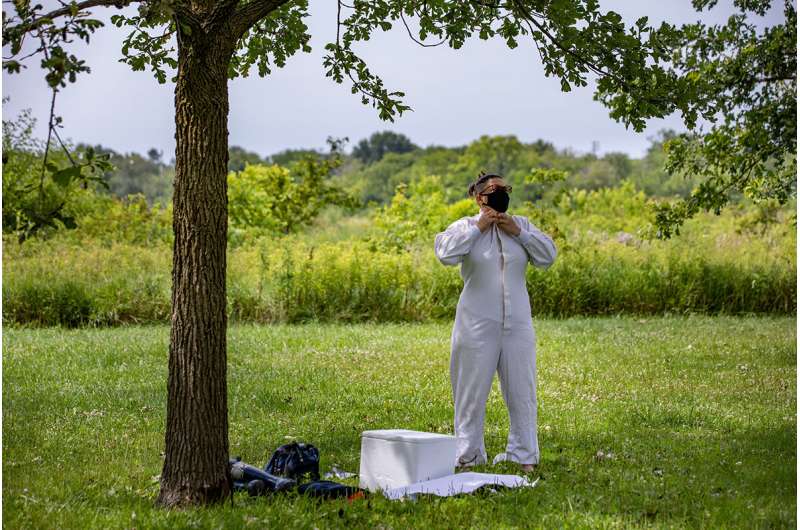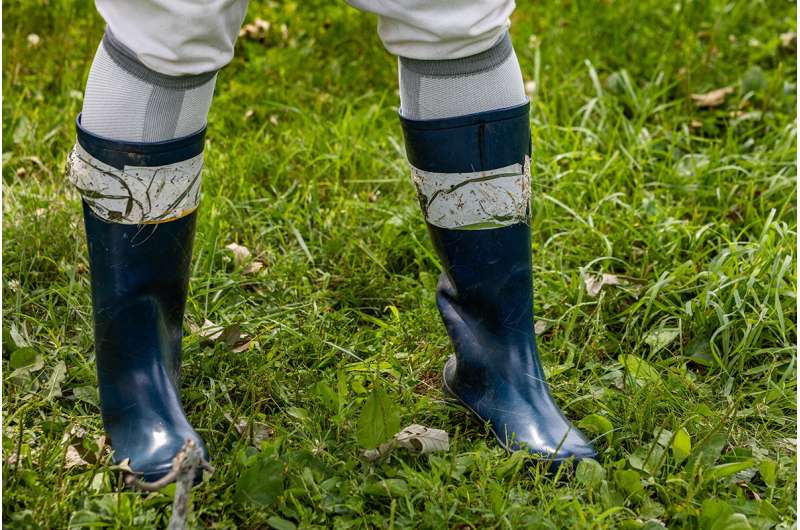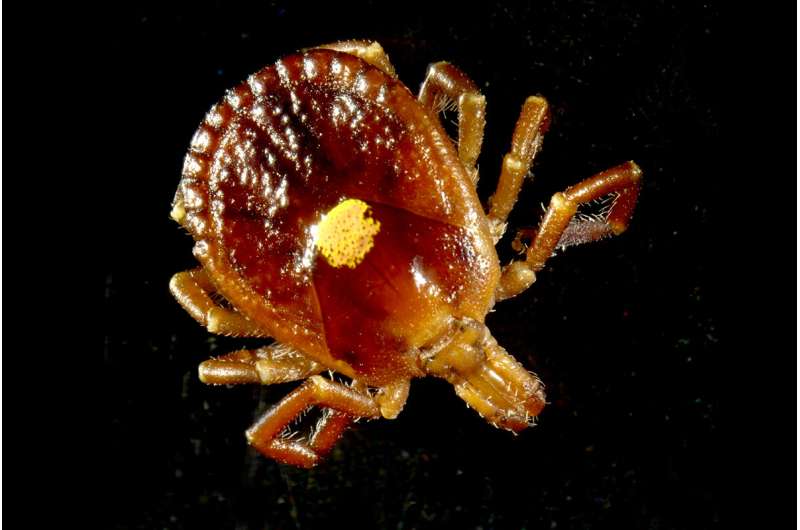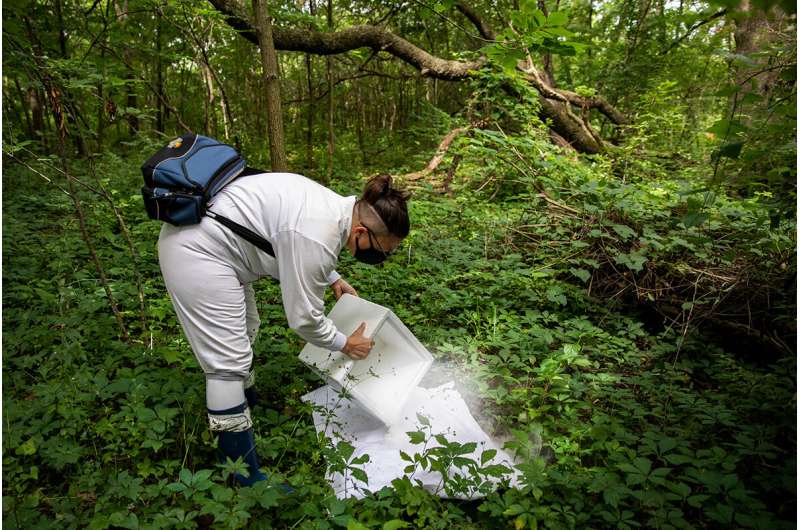Hunting a creature that hunts me: Collecting ticks for research

It's a sweltering summer afternoon. I'm pushing aside tree limbs and crunching leaves to get back to the trap that I baited two hours ago with dry ice to attract ticks. When I get closer, I can see a gossamer mist hovering over a bright white cloth in the dark underbrush. Dry ice "sublimates" in the open air, going from a solid to a gaseous state. It gives off a vapor of carbon dioxide gas that's denser than the air, mimicking the breath of a tick host resting on the ground.
When I reach the trap—a square of white cloth on the ground—I see that it's covered in ticks. Hooray! Quickly though, I realize that I've introduced my own CO2 to the scene, along with the added attractant of my body heat. Suddenly, I become the local target of choice for the ticks.
Lone Star ticks on the trap and in the leaf litter nearby begin running toward me and climbing up my boots. Am I surprised? No. They have eight legs! I face down what I call "the fear" and quickly grab my tweezers. I pick the ticks off my boots and from the trap, depositing them into collection vials. Dozens of ticks later, I pack up my trap and leave to go check the next one.
I am here at "tick ground zero" to investigate Heartland virus in Illinois ticks, working with the Illinois Department of Public Health and the Centers for Disease Control and Prevention. We are following up on reports of the first two human cases in the state.
Heartland virus is a dangerous pathogen, first discovered in 2009 in Missouri, that has caused more than 50 cases of human illness in 11 states in the South and the central United States. Human Heartland virus disease often requires hospitalization and is sometimes fatal. Most people with the disease become sick between May and September.

To determine the extent of infected ticks in the wild, we are collecting them at suspected sites of human bite exposure to test for Heartland virus. My colleagues and I are carrying thousands of ticks in our field bags, keeping the bloodthirsty arthropods alive to preserve the virus for testing. In 2019, we found that some Lone Star ticks in Illinois are indeed infected with Heartland virus.
I spend a lot of time thinking about how ticks move—first, to keep my tick-surveillance crew safe; second, to brainstorm new tick-collection methods; and third, because it's fascinating.
Many tick species engage in "sit-and-wait" behavior. They'll crawl up a blade of grass and wave their forelegs about, searching for chemical, thermal and other physical cues that tell them a host may be approaching. Then, if a host brushes past, the ticks transfer and hitch a ride on the host in an attempt to obtain their next bloodmeal.

But ticks also can engage in active pursuit. Yes, ticks can run after you. And after me and my field-surveillance crew. I find this unacceptable.
Lone Star ticks can ruin a sit-down in the woods, or even on a grassy lawn if it's too close to the edge of a forest where this species is present. And the Gulf Coast tick, which I suspect is a new invasive species in Illinois, can run at a speed of at least 12 feet per minute in open fields.

On a cool April morning in 2021, three days after a central Illinois snowfall, ticks slowly creep around on a cloth.
Lone Star tick larvae are tiny six-legged bloodsuckers that hatch en masse from egg deposits, clustering on blades of grass or the leaves of shrubs and low-growing plants. There they sit in a bloodthirsty clump until a tasty host—like me—passes by. When they transfer to a host, they look like the dust from a rotten cedar log. But then they slowly move out from the center and spread across my clothes.
So how do my colleagues and I protect ourselves from tick bites? We begin by putting coveralls over our day clothes. The coveralls are treated with a pesticide known as permethrin. We pull tight-weave, permethrin-treated socks up over our pant legs and we wear calf-high boots with double-sided carpet tape wrapped around the top of our boots.
If the boots are made of cloth or leather, they're also treated with permethrin. So are our cloth field bags. Permethrin gives ticks a condition known as "hot foot"—making it difficult for them to maintain contact with this potent acaricide. They fall backward to the forest floor, where they may later die if exposed long enough.
I also check myself every 10 to 20 meters, methodically visually scanning my body for ticks. If I spot an adult or nymphal tick, I either collect it in a vial or securely wrap it in tape, depending on the situation. I remove tick larvae with a lint roller. I shower within two hours of returning home and perform a thorough tick check. I dry my damp field clothes in a hot dryer for at least 20 minutes, remembering that heat, not water, kills ticks.
These techniques appear to be quite effective: In 2020, my crew and I collected over 5,000 ticks statewide and none of us were bitten. Knowing where ticks are in Illinois and what disease agents they might carry is important for protecting the health of Illinois residents and visitors. Most importantly, knowing how to prevent tick bites, and being prepared before going out, allows us to stop ticks in their tracks.
Provided by University of Illinois at Urbana-Champaign



















